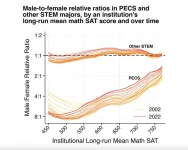(Press-News.org) Nature is pretty good at designing proteins. Scientists are even better. But artificial intelligence holds the promise of improving proteins many times over. Medical applications for such “designer proteins” range from creating more precise antibodies for treating autoimmune conditions or cancers to more effective vaccines against viruses. Applications may extend beyond medicine to, for example, growing better crops that could be more nutritious or absorb more carbon dioxide from the atmosphere. Investigators from Mass General Brigham and Beth Israel Deaconess Medical Center (BIDMC) have developed an artificial intelligence (AI) tool known as EVOLVEpro that may represent a leap forward in protein engineering. In a paper published in Science, the research team demonstrates the tool’s ability to make proteins more stable, precise, and efficient by applying the model to engineer six proteins with different applications.
“The power of a tool like this is that we’re not restricted by evolution. Using AI, we can choose to optimize a protein to be better in whatever way is needed,” said co-senior author Omar Abudayyeh, PhD, an investigator at the Gene and Cell Therapy Institute at Mass General Brigham and Engineering in Medicine Division in the Department of Medicine at Brigham and Women’s Hospital. Abudayyeh also has a secondary appointment in the Center for Virology and Vaccine Research at BIDMC and is an assistant professor at Harvard Medical School. “We can make a protein that’s better, faster, stronger. We can design it to be more efficient at binding to a target to improve a therapy or improve its function. If we can measure it, we can improve upon it.”
The concept of protein engineering is not new, but the emergence of AI and large language models is beginning to revolutionize the field. Protein language models (PLMs) can learn the “grammar” of proteins, reading protein sequences from across large genomic databases and offering suggestions that can improve proteins in ways that a scientist specifies. Much like new LLMs, EVOLVEpro acts as a layer on top of previous models, which can reason and provide more thought before responding.
“Protein modeling has advanced in recent years, and we wondered if we could now use large language models to essentially predict better protein sequences,” said co-senior author Jonathan S. Gootenberg, PhD, of the Center for Virology and Vaccine Research at BIDMC, member of the Gene and Cell Therapy Institute at Mass General Brigham, and member of the faculty at Harvard Medical School. “Our results consistently show how well this tool can work. We picked two clinically relevant antibodies—either already in use or close to human use—and found that with EVOLVEpro, we could engineer an antibody that could bind better and had better expression. Usually, you can do well on one of those outcomes, but here we saw improvements to both.”
Studies like this one show the promise of advances in gene and cell therapy technologies for transforming medicine. The Mass General Brigham Gene and Cell Therapy Institute (GCTI) was established in 2022 to fuel the discovery and development of targeted, transformative treatments that have the potential to cure diseases or halt their progression. The Institute unites more than 500 researchers and clinicians dedicated to advancing gene and cell therapy for first-in-human clinical trials, and ultimately, life-saving treatments for patients.
The research team for the Science paper, led by first authors Kaiyi Jiang and Zhaoqing Yan, of the Gene and Cell Therapy Institute at Mass General Brigham, and Matteo Di Bernardo at the Massachusetts Institute of Technology, used EVOLVEpro to engineer six proteins. The researchers found that the two monoclonal antibodies EVOLVEpro engineered were up to 30-fold better at sticking to their target. A miniature CRISPR nuclease was five times more effective at making genetic changes. A protein used for n gene editing, called a prime editor, was twice as good at inserting sequences into different parts of the genome. A protein called Bxb1 integrase was four times more efficient at inserting DNA into cells for programmable gene integration applications, and a protein for RNA production, a T7 RNA polymerase, was 100 times better at making accurate copies of RNA, which is important for manufacturing mRNA for mRNA therapies or vaccines.
“We anticipate that this is just the beginning for EVOLVEpro, which will continue to improve with time and could be used for a wide variety of protein engineering applications,” said Jiang. “This technology marks the beginning of a new era where we can design proteins not just to match nature's designs, but to solve challenges nature never had to face—from creating more precise medicines to developing proteins that could help address global challenges like climate change and food security."
Authorship: In addition to Gootenberg, Abudayyeh. Jiang, and Yan, Mass General Brigham authors include Samantha R. Sgrizzi, Lukas Villiger, Alisan Kayabolen, and Josephine K. Carscadden. Additional authors include Matteo Di Bernardo, Byungji Kim, Masahiro Hiraizumi, and Hiroshi Nishimasu.
Disclosures: Gootenberg, Abudayyeh, Jiang, Di Bernardo, Villiger, and Yan have filed patents related to this work with provisional patent (#63/509,139). Gootenberg and Abudayyeh are co-founders of Sherlock Biosciences, Tome Biosciences, Doppler Biosciences, and Circle Labs. No companies are currently involved in commercializing this technology.
Funding: National Institutes of Health (1R21-AI149694, R01-EB031957, 1R01GM148745, R56-HG011857, and R01AG074932) the K. Lisa Yang and Hock E. Tan Center for Molecular Therapeutics in Neuroscience; Impetus Grants; the Cystic Fibrosis Foundation Pioneer Grant; Google Ventures; Pivotal Life Sciences; MGB Gene and Cell Therapy Institute; the Yosemite Fund; JSPS KAKENHI (21H05281 and 22H00403), the Takeda Medical Research Foundation, the Inamori Research Institute for Science, and JST, CREST (JPMJCR19H5 and JPMJCR23B6).
Paper cited: Jiang K et al. “Rapid in silico directed evolution by a protein language model with EVOLVEpro” Science DOI: 10.1126/science.adr6006
For More Information:
Gene and Cell Therapy Institute
###
About Mass General Brigham
Mass General Brigham is an integrated academic healthcare system, unites great minds to solve the hardest problems in medicine for our communities and the world. Mass General Brigham connects a full continuum of care across a system of academic medical centers, community and specialty hospitals, a health insurance plan, physician networks, community health centers, home care, and long-term care services. Mass General Brigham is a nonprofit organization committed to patient care, research, teaching, and service to the community. In addition, Mass General Brigham is one of the nation’s leading biomedical research organizations with several Harvard Medical School teaching hospitals. For more information, please visit massgeneralbrigham.org.
END
BATON ROUGE – A team of researchers led by Pennington Biomedical Research Center’s Dr. Florina Corpodean confirmed through a data analysis that metabolic and bariatric surgery is largely safe and effective for patients who are experiencing severe obesity. In the recent study “BMI ≥ 70: A Multi-Center Institutional Experience of the Safety and Efficacy of Metabolic and Bariatric Surgery Intervention,” published in Obesity Surgery: The Journal of Metabolic Surgery and Allied Care, researchers affirmed ...
Highlights:
Researchers from Michigan State University are the first to measure the brain activity of people who had never been to a specific city and then use this brain activity to predict other people’s actual visits to places around that city. This offers potential applications for urban planning and design that addresses the well-being of residents and visitors.
For this study, researchers used principles from the budding field of neurourbanism, which involves measuring the human brain to predict and understand the influence of urban environments on behavior.
The study’s findings suggest that the neural activity in the ventromedial prefrontal cortex — a key region ...
ACM, the Association for Computing Machinery, named an eight-member team drawn from Australian and American institutions as the winner of the 2024 ACM Gordon Bell Prize for the project, “Breaking the Million-Electron and 1 EFLOP/s Barriers: Biomolecular-Scale Ab Initio Molecular Dynamics Using MP2 Potentials.”
The members of the team are Ryan Stocks, Jorge L. Galvez Vallejo, Fiona C.Y. Yu, Calum Snowdon, Elise Palethorpe (all of Australian National University); Jakub Kurzak (Advanced Micro Devices, Inc.); Dmytro Bykov (Oakridge National ...
Marking a bold step in its transformation into a global research powerhouse, NYU Tandon School of Engineering welcomes Jeffrey Hubbell, a world-renowned chemical engineer and member of four National Academies, to spearhead an ambitious agenda integrating engineering, the sciences, and medicine, to advance healthcare innovation.
As part of this vision, Hubbell will lead a new cross-institutional initiative to translate scientific discoveries into pioneering treatments. A collaboration led out of NYU Tandon and Langone Health, the initiative will include unprecedented investments in new faculty, state-of-the-art new facilities, ...
Link to Google Drive folder containing images (caption and credit information below):
https://drive.google.com/drive/folders/1r5eJr78OdIYV0la1pBvRx-ksu9hsNqcw?usp=sharing
Post-embargo link to release:
https://www.washington.edu/news/2024/11/21/whale-ship-collisions/
FROM: James Urton
University of Washington
206-543-2580
jurton@uw.edu
(Note: researcher contact information at the end)
Embargoed by Science
For public release at 2 p.m. U.S. Eastern Standard Time (11 a.m. Pacific Standard Time) ...
A new study on ageing in the animal kingdom has highlighted how urgently Earth’s oldest and wises creatures must be protected, with knowledge and environmental stability lost due to human intervention.
The new study, led by Charles Darwin University’s (CDU) Research Institute for the Environment and Livelihoods (RIEL), explores the consequences of the loss of old, often large and wise animals in the wild and the value these individuals have to scientific knowledge, biodiversity and more.
Humans are responsible ...
Nationally, men in colleges and universities currently outpace women in earning physics, engineering, and computer science (PECS) degrees by an approximate ratio of 4 to 1. To better understand the factors driving these gaps, NYU researchers analyzed bachelor’s degrees awarded in the US from 2002-2022, and found that the most selective universities by math SAT scores have nearly closed the PECS gender gap, while less selective universities have seen it widen dramatically.
“These findings challenge our understanding of gender inequality in STEM education,” says Joseph Cimpian, the study’s lead author and professor of economics and education ...
A team of researchers from the United States and Switzerland have reported the discovery of a previously unknown compound in chloraminated drinking water. Inorganic chloramines are commonly used to disinfect drinking water to safeguard public health from diseases like cholera and typhoid fever. It’s estimated that more than 113 million people in the United States alone drink chloraminated water.
The researchers have now identified chloronitramide anion, chemically expressed as Cl–N–NO2−, as an end product of inorganic chloramine decomposition. While its toxicity is not presently known, its prevalence and similarity to other ...
Many public water systems in the United States use inorganic chloramines to disinfect drinking water, but their decomposition products have long been a mystery. In a new study, researchers report the discovery of chloronitramide anion – a compound whose existence, though not identity, has been known for 30 years. Detected in the tap water of millions of Americans, this compound’s toxicity remains untested, prompting calls for immediate toxicological evaluation and raising questions about the safety of chloramine in public water supplies. For over a century, chemical disinfection of public water ...
Cultural complexity in chimpanzees depends on migration and interaction between groups, echoing early human patterns of cultural evolution, researchers report in a new study. The findings offer insight into the development of cumulative culture in early hominins. Culture, defined as a set of socially learned behaviors, has been increasingly documented across various animal species. However, human culture stands out for its complexity and cumulative nature, where cultural knowledge builds upon previous innovations. While chimpanzees – humans’ closest relatives – demonstrate a variety of cultural ...



